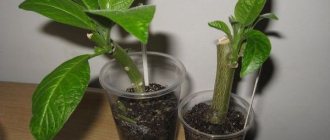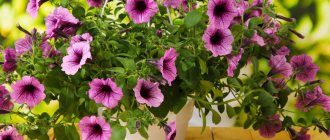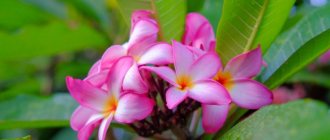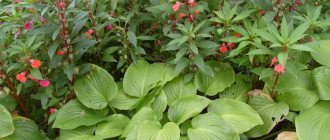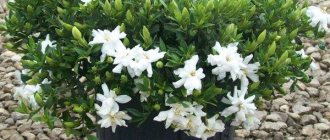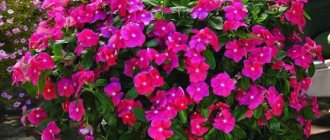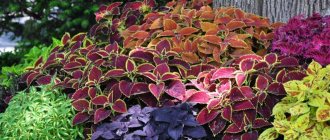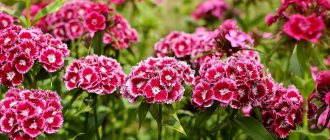Author: Miroslava Danich Category: Houseplants Published: April 16, 2013Last edits: November 16, 2020
I have long dreamed of this beauty - gardenia jasmine . But the prices for this flower in our stores scared me away. Already a large adult flower costs a lot, but they say that specimens grown in a greenhouse practically do not survive at home. Changes in temperature and humidity levels have an effect. It is believed that you need to purchase adapted plants for your home. But they don't sell them. What a real amateur gardener does in such cases is try to grow the flower he likes. After all, the process is sometimes much more interesting than the result. Of course, growing homemade gardenia from seeds is not so easy, but it’s quite interesting to try. You can also try to propagate it by cuttings. So far I haven’t found anyone to ask for a cutting, so I decided to buy gardenia jasmine seeds and began to study the issue. Then she put the obtained information into practice. And in case someone decides to follow my example, I’ll tell you what I learned about gardenia jasmine, and what happened.
Description of the flower
Gardenia is an evergreen shrub native to South America, East and Southeast Asia. Jasmine gardenia has taken root in temperate latitudes. The indoor flower grows up to 50 cm in height. The color is white, some varieties have a terry texture of the petals. It has a subtle, jasmine aroma that the plant emits during flowering. Just one flower is enough to fill a room with a unique fragrance. You can learn about other varieties of gardenia in another article.
The leaves are dark green, rich in color, with a smooth surface and a glossy sheen. Gardeners prefer gardenia for its decorative foliage that remains attractive throughout the year.
In order for your pet to please you for a long time and bring only benefits, we suggest that you read several articles about gardenia:
- Useful properties of the plant.
- Pests and diseases of gardenia.
- Problems with leaves and ways to solve them.
Varieties and varieties of gardenias
Over a long period of cultivation, breeders have developed many types of gardenia, which are successfully grown at home:
- Golden Magic. This species is characterized by a long flowering period, during which the white corolla turns into a golden color.
- The dwarf, slow-growing species Radican Variegata has variegated dark green leaves with a pronounced cream stripe along the edge. Mature plants can grow up to 1 m in height. Flowering occurs in summer. The flowers are large, 5-6 cm in diameter.
- The Amy variety has light green leaves and double flowers reaching 12 cm in diameter. Blooms twice a year.
- Gardenia jasmine Belmont has densely double leaves of a rounded shape. Flowers with a diameter of 10 cm emit an amazing aroma. This species is resistant to cold and disease.
- Gardenia Beauty is a beautiful species with large, double white flowers that bloom in early summer and last until fall. This plant blooms profusely and is very popular.
- The Variegata variety has variegated leaves and fragrant flowers with a diameter of 8 cm. A slow-growing small shrub is ideal for growing in flowerpots. The leaves are round in shape and variegated in color - an original combination of light green and cream color.
- Mystery is a very popular variety of gardenia, characterized by large leaves of rich dark green color and huge flowers with a diameter of 12-13 cm. Flat double flowers bloom twice a year.
- Gardenia jasminoides is a whimsical plant and has some difficulties in growing at home. The main care for gardenia is as follows.
Reproduction methods
Today there are two known methods of propagating jasmine gardenia:
Seminal. With the seed propagation method, the main problem is the freshness of the seed; the germination of seedlings depends on this characteristic. It is worth recalling that gardenia seeds are poisonous; when planting with them, you need to be careful and use personal protective equipment. But the advantage of this method of propagation is the affordable price of seeds, which are easy to purchase at any flower shop.- Cuttings. With the vegetative propagation method, the woody upper parts of the shoots serve as planting material. In this case, the cuttings must certainly be healthy and not under stress. The shoots are rooted in the summer in mini greenhouses, after regular bush formation procedures. Such rooted young plants can bloom 6 months after transplanting into a pot.
Video
Video with step-by-step steps for planting gardenia seeds:
Sources
- https://Vikings-WarOfClans.ru/cvety-doma/gardeniya-iz-semyan-v-domashnih-usloviyah.html
- https://chistiy-dom35.ru/komnatnye/gardeniya-vyrashchivanie-iz-semyan.html
- https://roza-zanoza.ru/rasteniya/gardeniya-zhasminovidnaya-vyrashhivanie-iz-semyan-osobennosti-rasteniya.html
- https://rusfermer.net/dom-kvartira/tsvety-kv/tsvetushhie/gardeniya/virachivanie-iz-semyan.html
- https://selo.guru/rastenievodstvo/derorativ/garden/vyrashhivanie-iz-semyan.html
- https://erpstat.ru/domashnie/gardeniya-zhasminovidnaya-iz-semyan.html
- https://dacha.expert/domashnie-rasteniya/tsvetushhie/gardeniya/vyrashhivanie-iz-semyan-g.html
- https://kupit-utyug.ru/cvety-doma/gardeniya-iz-semyan-2.html
- https://rayskisad.ru/dekorativnoczvetushhie-rasteniya/gardeniya-iz-semyan-v-domashnih-usloviyah-kak-eyo-vyrastit
When does it reproduce?
The optimal period for sowing planting material is the end of February - the beginning of March. At this time, the length of daylight increases significantly, and the weather becomes warmer. The germination period of seeds varies within 30-40 days from the moment of sowing.
Before planting, the soil must be warmed up so that it becomes warm. You can also sow seeds in the summer, but then it is important to monitor the temperature so that the germinated seedlings do not get too hot. Otherwise it will simply dry out.
Possible problems
Since indoor gardenia jasmine has a demanding and capricious disposition, gardeners often have problems with it. For example:
- Flying around flowers and buds . The bush has been moved from one place to another or the room is excessively cold.
- Yellowing of foliage . Inappropriate water is used to moisten the substrate. For irrigation, you need to take non-cold and soft water.
- Darkening and drying of the edges of leaf plates . The bush is not watered in a timely manner; the air humidity in the room is too low.
- Formation of dark spots on leaf blades . Regular stagnation of water in the substrate. There may be rot on the roots.
- Flying around the buds . The room temperature is excessively low or high.
- Pests . A scale insect or spider mite may settle on the plant. To get rid of them, you need to treat the bush with an insecticidal agent.
Recommendations for cultivation
Growing gardenia from seeds is a long and labor-intensive procedure. As already mentioned, the main factor influencing the similarity of seedlings is the freshness of the seeds, so when purchasing, pay attention to the packaging date indicated on the package. However, there are cases that out of 5 purchased seeds, only 1-2 pieces germinate.
If you want to get the seeds yourself, then it is important to know:
- gardenia blooms in the 5th year of life, but it is possible earlier with quality care (you will learn about why gardenia does not bloom and what needs to be done in this article);
- the flowering period lasts from March to September;
- at the end of flowering, seed boxes appear;
- the shape of the seed is oval, with one end pointed and the other round;
- the average seed size is 4-5 mm;
- the color of high-quality fresh material is light and dark brown;
- after collecting the boxes, they should be dried well and subsequently stored in a dry place where there is no access to moisture;
- The shelf life of seeds is no more than 2-3 years.
Bottom line
So, first we need to buy seeds. I can’t recommend which manufacturer to choose, because after one experience, I somehow didn’t want to further grow flowers from seeds. Nowadays I prefer, where possible, to “steal” cuttings from flowers I like.
By the way, when buying seeds, don’t forget about the soil so you don’t have to go to the store a hundred times. As for the soil, it is better to buy gardenia with neutral or slightly acidic acidity. It will not be difficult to choose, since all the information is written on the purchased soil and there is even a list of colors for which the soil is suitable. I noticed this quite recently, because previously, out of stupidity, I did not pay attention to the inscriptions on the package. If you are too lazy to read, then consult a seller who knows his product by heart (unless, of course, he has not been working for a couple of weeks).
Well, if you don’t want to think about what soil to choose, buy soil for azaleas or roses.
When you get home, you can start planting the seeds. If it is winter time, then leave the ground to warm up a little for a while (to room temperature).
Take a small pot, put a layer of drainage on the bottom and cover it with soil. I immediately water the soil abundantly, when the water is absorbed, I pour out the seeds and cover it with dry soil on top. Many gardeners advise moistening the soil after planting seeds with a spray bottle. You can do as you please.
For successful seed germination, the bottom of the pot must be warm. Of course, you can put the pot on the radiator, which is not always convenient. You can take any plastic box (for example, a cake box, or cakes are now sold in large plastic boxes). At the bottom of the box, put something for elevation; you can cut off tree branches that are not too thin (twigs) and place a pot of gardenia seeds on top of them. Cover the box and place it on top of the kitchen cabinet, where it is very warm.
Many sources write that seeds begin to germinate in a month, but from my own experience I will say that this happens a little faster. When you see sprouts, move the box to the windowsill. However, it is important that the bottom of the pot retains heat and for this you can wrap the pot in a warm cloth, or put polystyrene foam underneath and around it.
Important! Do not over-water the seedlings, therefore, try not to water them often, however, do not allow the soil to dry out. The seedlings grow very slowly, but when 2 true leaves appear, they can be transplanted into separate containers. Just take small pots, since in a large pot the plant grows very, very slowly.
If you are afraid to flood your small plants, then you can take a larger pot, fill it with drainage, and place a container with seedlings on top. In the future, water small gardenias not in the ground, but in expanded clay.
After about two months, when the plants gain strength and the old pot becomes cramped, you can transplant them into another container, 1.5 cm larger, and care for them as if you were an adult gardenia.
How to grow at home?
So, to grow an exotic beauty at home, you can follow 2 ways:
- buy an adult plant at a flower shop;
- Try growing seedlings from seeds yourself.
The first option is certainly simpler and more reliable. And the seed method is suitable for purposeful flower lovers, and you can still save a considerable amount. After all, a full-fledged plant costs tens of times more than a bag of seeds.
So, before starting the planting process you should prepare:
- fresh gardenia seeds;
- wide, shallow container;
- fine fraction drainage;
- earthen mixture for azaleas, this particular substrate is optimal for young gardenias;
- the warmest place in the house.
Let's break it down step by step:
- The first step is to prepare the soil; you can take a ready-made substrate or make it yourself. In this case, you will need in equal proportions: peat, sand and deciduous soil (you can find out how to choose soil for gardenia, as well as what pot you need when planting, here). Move all components carefully. In winter, the soil should be warmed to room temperature.
- A drainage layer 4-5 cm thick is placed at the bottom of the prepared container. Soil is poured on top. The soil is watered abundantly, then the seeds are spread evenly.
- A day before planting, the seeds are soaked in warm boiled water with the addition of the stimulant Kornevin, 3 drops of liquid preparation per 100 ml of water. Then the seeds are carefully planted in the soil; it will be more convenient to use tweezers. The distance between the seeds is 3-4 cm, and the depth is no more than 5 cm.
- A dry layer of soil is sprinkled on top of the sowing. You can not water the soil in advance, but after planting, spray the soil with water from a spray bottle.
- Cover the container with a clear plastic bottle or plastic bag to maintain greenhouse conditions. Then move the pot to a warm place. Make sure that the temperature in the greenhouse is +20-24°C and high humidity, which is created by regular spraying with water. Don’t forget to ventilate the greenhouse daily and remove condensation.
Reference! Many sources indicate germination time as 1 month, but in practice, seedlings germinate much faster.
Choosing seeds and soil for gardenia
In order to get young seedlings, you will need to choose the right soil and purchase high-quality seeds. It is better to buy seeds in specialized flower shops. This way you can be sure that the seeds will be fresh and they have been stored correctly.
Gardenia grows well only in loose and acidic soil. The plant belongs to the Rubiaceae family, for which there is a special substrate. You can also buy it in the store. Some gardeners claim that you can grow a flower using azalea soil mixture.
Soils
It is recommended to use acidic soil for planting flowers. Only under such conditions does it develop fewer diseases, and it grows successfully and actively, thanks to the beneficial substances that the soil contains. To grow it at home, you can take a special soil mixture for Rubiaceae. If watering is done with hard water, then the soil must be periodically acidified using the method given above.
For such a plant, quickly drying soil that can retain moisture is very suitable. To achieve this effect, sphagnum, perlite and sand are added to the soil for planting gardenias. These components have acidifying properties.
What to do after germination?
When the young plants get stronger and several leaves appear, it’s time to pick. That is, planting sprouts in separate containers. Small glasses or pots with a diameter of no more than 10 cm are suitable for this; it is advisable to cover the top with cut plastic bottles. After all, the sprouts are not yet ready for the indoor microclimate.- After a month, remove the bottles and perform the first feeding. Make the fertilizer concentration 2 times weaker than indicated in the instructions, in order not to overfeed the plant.
- Every 10 days, spray the leaves with Ferovit to prevent chlorosis. When watering, you need to add lemon juice to the water, thus acidifying the soil. Add 4-5 drops of juice to 1 liter of water. Instead of juice, you can use citric acid.
- To make the bush voluminous, the upper shoots should be pinched.
- After a year, it is worth changing the place of residence of the flower.
- In the future, care for it in the same way as for an adult gardenia.
As it turned out, germinating gardenia seeds at home is not such an impossible task. The main thing is to want it and everything will certainly work out. Perhaps not all seedlings will survive the first time, but with time and experience gained, the result will improve noticeably.
Picking
After the second pair of leaves appears, the seedlings are distributed into separate pots.
The container should be 2-3 cm larger than the clod of earth with which the plant is transplanted. Young sprouts are not yet ready for indoor conditions; they are covered with cut-off plastic bottles to maintain the microclimate.
In a month, they will have to be replanted again and the first feeding done (you can read about how to transplant gardenias at home here). Fertilizer for azaleas is taken, but diluted in a concentration half as much as indicated.
Important. Sprouts are susceptible to chlorosis due to lack of iron. If the seedlings turn pale green, it’s time to spray them with ferovite.
Iron deficiency occurs when the soil becomes alkalized. It can be prevented by adding citric acid to the water for irrigation.
In order for the bush to develop in breadth, the top shoots are pinched. Further care is similar to maintaining an adult plant. It is enough to change his place of residence once every 2 years. The most difficult and exciting moments are behind us, all that remains is to wait for the first flowering.
Growing and maintaining gardenia requires compliance with many rules. It reacts to the slightest deterioration in the optimal microclimate by deteriorating its appearance. But beautiful fragrant flowers, reminiscent of roses, become a reward for the hard work and patience of the gardener.
How to save a plant from diseases and pests
Gardenia is prone to various diseases; a capricious plant, with any violation of care, can develop chlorosis, carbon mold and other diseases.
Table: why diseases appear and how to revive a plant
| Diseases and pests | Signs | Reason for appearance | Treatment and prevention measures |
| Chlorosis | The leaves turn pale and yellow streaks appear on them. If chlorosis is not treated, the plant may die. | iron deficiency |
|
| Charcoal mold | The leaves begin to darken. Affected leaves may fall off. | lack of light and poor air circulation |
|
| Mealybug | White lumps similar to cotton wool appear on the leaves. | excessive dampness |
|
| Thrips | Grayish-white dots form on the leaf blades. | excessive dry air | Treat gardenia with insecticidal soap or Decis (according to instructions). |
| Shchitovka | Brown bumps and sticky discharge form on the leaf blades. The leaves become paler in color. | insufficient humidity in the room |
|
| Whitefly | Greenish larvae cover the underside of the leaves. Severely affected leaf blades turn yellow and fall off. | overwatering |
|
| Spider mite | The visible mark of the mite is a thin web on the plant. Insects suck the juice from the leaves. If measures are not taken in time, the leaves may wither, turn black and ultimately dry out. | the air is too dry |
|
